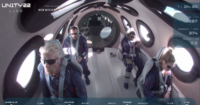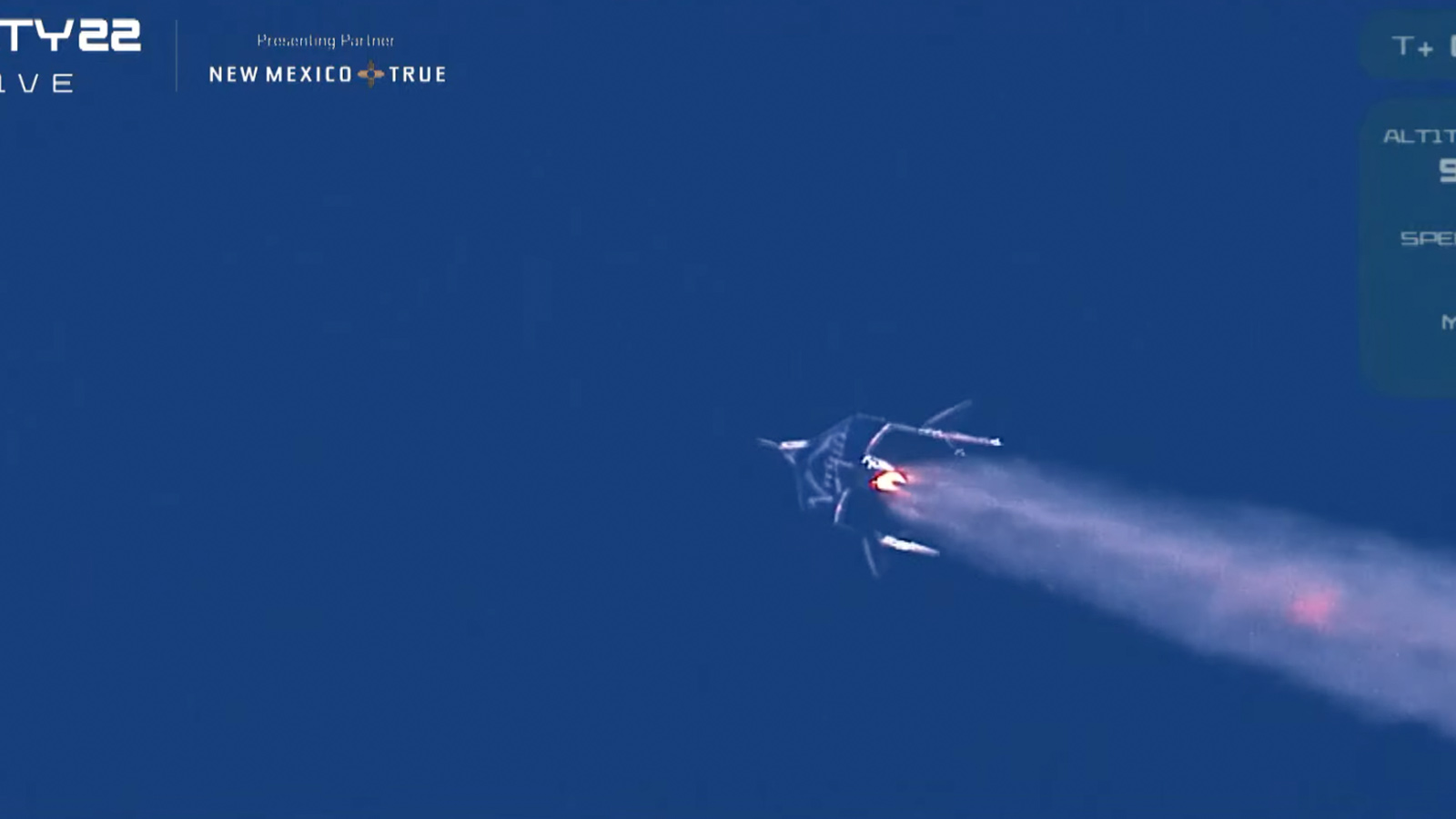Stay Up to Date
Submit your email address to receive the latest industry and Aerospace America news.
STORY UPDATE JULY 20: Bezos and three others reached space, landed in West Texas at 8:22 local time today. Virgin Galactic's VSS Unity landed at 9:40 a.m. July 11 in New Mexico
DETAILS: Footage from inside the New Shepard capsule released by Blue Origin during a post-flight event showed a darker cabin and brighter Earth, compared to Virgin Galactic’s livestream from inside VSS Unity.
At a basic level, Virgin Galactic’s flight on July 11 sounds a lot like the one Blue Origin plans to make nine days later: Both would send the company’s billionaire founder and three passengers past the 80-kilometer boundary that the United States considers the edge of space. Both would allow passengers to unbuckle from their seats to enjoy several minutes of weightlessness and a view of Earth that only a few hundred humans have ever experienced. And both are intended to be the first of many flights that could open up the space frontier to a larger segment of the population.
But the experiences of those aboard each vehicle will differ significantly.
Consider the length of the flights: If all goes as planned, Virgin’s Richard Branson and passengers will spend about 90 minutes in motion inside VSS Unity, much of the time buckled in. First, with Unity cradled by the WhiteKnightTwo carrier plane, they must taxi to the head of the runway at Spaceport America in New Mexico. WhiteKnightTwo will then climb to an altitude of 50,000 feet and release Unity. Seconds later, Unity will ignite its single hybrid rocket motor, so called because it mixes solid propellant with liquid nitrous oxide, which will fire for 60 seconds, propelling Unity to an altitude of about 80 kilometers. After the thrilling minutes of weightlessness, pilots must pull a series of handles to raise Unity’s tail booms in what Virgin calls a feathered configuration, meant to increase drag as Unity sinks back into the atmosphere and glides to a runway landing back at Spaceport America.
By contrast, Jeff Bezos’ trip aboard the New Shepard rocket and capsule on July 20 — the first flight with people — would clock in at around 11 minutes. The journey will begin when the rocket’s single engine ignites, propelling the capsule off the West Texas launch pad to an altitude of 75 kilometers, where it will separate and keep ascending to about 100 kilometers. After three minutes of weightlessness, the capsule will fall and touch down in a gentle parachute landing near the launch site.
Virgin and Blue also have different design philosophies about how to maximize the view. In test flights, Virgin pilots have rehearsed rotating the spaceplane 360-degrees to give passengers panoramic views of the Earth silhouetted against the black of space via the 12 circular windows dotted along the cabin walls and ceiling. Virgin would not say if pilots will do this maneuver Sunday.
“The interior of the spaceship was designed with one thing in mind: the view of the Earth from space,” then-CEO George Whitesides said during a livestream last year.
Blue Origin will provide breathtaking views with a different approach: Bezos, his brother Mark, aerospace pioneer Wally Funk and a passenger who paid $28 million will each sit next to their very own meter-tall window. Virgin passengers will be able to speak with the Unity pilots via earpieces and comms buttons on their flight suits, as the pilots control the craft. Those aboard the New Shepard capsule will have to put their faith in bits and bytes. From launch to landing, the New Shepard flights are controlled by onboard computers and automated navigation software, though Blue mission controllers on the ground can intervene if need be and passengers can push a button on their seats to speak with those controllers.
Will this autonomy put Blue at a disadvantage? Laura Forczyk of the Georgia space consulting firm Astralytical doesn’t think it will be a deal breaker because of the short duration of the flight, based on her interviews with future and prospective passengers for a book she’s writing about space tourism.
“It might be that people are OK with a joy ride that lasts 10, 11 minutes with no one but their fellow passengers,” she said, but a 90-minute flight like the one Virgin provides would be too long to go without a human attendant. “I’d say there’s certainly room for both approaches right now, if they’re safe.”
There’s no shortage of would-be participants. Blue hasn’t said what it plans to charge for New Shepard flights, but Virgin in filings to the U.S. Securities and Exchange Commission has said about 600 paying customers have purchased a $250,000 ticket to reserve their spot on a future flight. Those rides are scheduled to begin in 2022.
For now, that price tag puts space tourism flights out of reach for all but wealthy individuals, but both Blue and Virgin hope it’s a first step toward “making space more accessible for all,” as Branson put it in a video announcement of his flight.
Branson’s flight
WHERE TO TUNE IN: Virgin Galactic’s livestream via its website and social media pages. Citing “weather overnight,” the company bumped the start of coverage by 90 minutes, to 8:30 am New Mexico time on Sunday (10:30 am Eastern).
WHAT YOU’LL SEE: The first fully crewed test flight of VSS Unity. Virgin Galactic founder Richard Branson will ride with three employees and two pilots.
DID YOU KNOW?
- Sunday’s flight is called Unity-22 because it’s the 22nd test flight of the spacecraft.
- Until now, Unity has been restricted to carrying two pilots, except in one case: a February 2019 flight when the pilots were joined by Beth Moses, the chief astronaut instructor.
- Each crew member has a specific role: Sirisha Bandla, vice president of government affairs and research operations, will evaluate the “human-tended research experience.” Colin Bennett, the lead operations engineer, will access the “private astronaut experience” during the ascent and weightlessness phases. Beth Moses will oversee the test-flight objectives.
- Crew member Bandla is a member of the AIAA ASCEND Guiding Coalition.
About cat hofacker
As acting editor-in-chief, Cat guides our coverage, keeps production of the print magazine on schedule and edits all articles. She became associate editor in 2021 after two years as our staff reporter. Cat joined us in 2019 after covering the 2018 congressional midterm elections as an intern for USA Today.
Related Posts
Stay Up to Date
Submit your email address to receive the latest industry and Aerospace America news.





